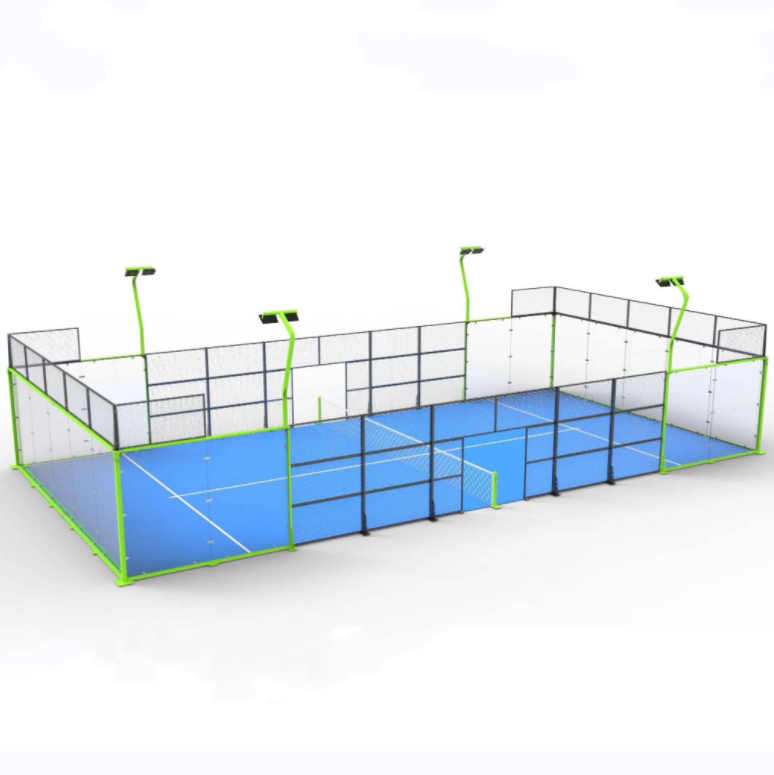What is the difference between pickleball and padel?
Pickleball and padel differ significantly in their origins, courts, equipment, rules, and characteristics. The specific differences are as follows:

1. Origins and Sports Genetics
Pickleball: Originated in Seattle, USA in 1965, it evolved from a family gathering where ping-pong paddles and plastic balls replaced badminton equipment. It combines the characteristics of tennis, badminton, and table tennis, and is known as an "American hybrid sport."
Padel: Originated in Mexico in the 1960s and later became popular in Spain, it combines elements of tennis, squash, and badminton, emphasizing tactical confrontation within a closed court and is considered a "Latin sport."
2. Court and Space
Pickleball:
Dimensions: Same as a badminton doubles court (13.4 meters long x 6.1 meters wide). The net is 86.36 cm high in the center and 91.44 cm high on both sides.
Boundaries: Unwalled; points are lost if the ball goes out of bounds. Non-volley zone: The area extending 2.13 meters from either side of the net. Players are prohibited from volleying untouched balls within this area.
Patley tennis:
Dimensions: 20 meters long x 10 meters wide, approximately one-third the size of a tennis court, enclosed by a 3-meter-high tempered glass wall and metal mesh.
Bounce rule: The ball can bounce once off the glass wall and continue hitting, increasing tactical diversity.
Space: The enclosed court makes the ball's trajectory more complex, requiring the player to anticipate the bounce angle.
III. Equipment and Equipment
Pickleball:
Racket: Horizontal grip design, materials have evolved from wood to carbon fiber and fiberglass, weighing 200-250 grams (about half a bottle of mineral water), with a perforated face to reduce wind resistance.
Ball: A hollow ball made of a thin hard plastic shell, approximately 7.3-7.5 cm in diameter, with 26 1 cm diameter holes on the surface to reduce flight speed.
Clothing: Casual sportswear is acceptable; no requirements are mandatory. Pad Tennis:
Racket: Stringless design, with a perforated EVA foam face. Dimensions no greater than 45.5 x 26 cm, thickness no greater than 38 mm, weight 320-375 grams.
Ball: Similar to a tennis ball but smaller (6.35-6.77 cm in diameter), with lower air pressure and a lower bounce.
Clothing: Requires a racquet strap. Professional players often wear fashionable sportswear.
IV. Rules and Gameplay
Pickleball:
Serve: Serves with an underhand touchdown. Odd-numbered players serve in the left court, even-numbered players in the right court.
Scoring: Serves on a point-scoring system, with 11 points per set (a two-point lead is required), best-of-three.
Double Ground Rule: After serving, both players must each hit a groundstroke before attempting a volley.
Non-Volley Zone Rule: Volleys are not permitted in this zone. Paddy Tennis:
Serve: A ground serve with the underhand touch, with the server standing outside the baseline and the ball hitting below the waist.
Score: 11 points per set (must be ahead by 2 points), best-of-five, doubles only.
Bounce: The ball can bounce off the glass wall once and then continue to be hit, but the number of times it lands is limited to one.
Freedom of Movement: Players can move freely within and outside their own half of the court, but must not interfere with their opponents.
V. Sport Characteristics and Audience
Pickball:
Accessibility: The slow ball speed and small court make it suitable for all ages, including children and the elderly.
Social Attributes: Often used as a family gathering or community activity, it emphasizes interaction and fun.
Global Data: Approximately 25 million players in the United States and over 36 million worldwide, with growing popularity among young people in China.
Paddy Tennis:
Tactical Depth: The enclosed court and ball bounces increase the uncertainty of the game, requiring quick reactions and strategic planning. Physical Requirements: While less intense than tennis, it still requires a certain level of endurance and coordination, making it suitable for young and middle-aged players.
Global Data: Over 25 million players worldwide, with an annual growth rate exceeding 30%. Popularity is high in countries like Spain and Argentina.
VI. Summary of Core Differences
Dimensions: Pickleball, Paddy Tennis
Venue: Open badminton court, no walls; Enclosed court with glass walls, allowing the ball to bounce
Racket: Lightweight, perforated, similar to a large table tennis racket; Stringless foam racket, similar to a table tennis racket but larger
Ball: Plastic, porous ball, slow-moving; Similar to tennis, but smaller, with lower air pressure
Rules: Emphasizes no-volley zones and double-landing rules; Allows for wall bounces, making tactics more complex
Sport Characteristics: Casual, social, and suitable for all ages; Tactical, competitive, and primarily for young and middle-aged players
padel court,Gymnastic mats, basketball racks, volleyball posts, tennis dwellings, badminton posts, adult gymnastic equipment, parallel bars, horizontal bars, uneven bars, gymnastic rings, balance beams, saddles, hydraulic referee tables, table tennis tables, outdoor fitness equipment, garden fitness equipment
Website:
http://www.hransports.com/faq/298.html